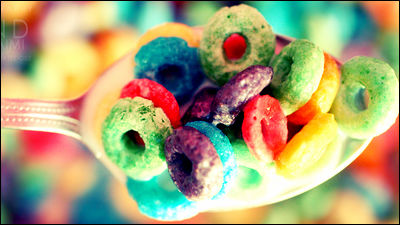'The color wheel is wrong,' says Professor Ito. How does color vision actually work?

Color Wheels are wrong? How color vision actually works
https://longform.asmartbear.com/color-wheels/
The image below shows a color wheel by Nekia Torres , a fashion blogger. Here, the 'primary colors ' red, blue, and yellow are arranged in a triangle, with the ' secondary colors ' where the primary colors are mixed at the midpoint, and the 'tertiary colors' where the primary colors are mixed between the secondary colors. A diagrammatic configuration that shows colors in an abstract circular shape like this is called a color wheel, color wheel, or color circle.

Cohen uses the color wheel as an example, pointing out that 'the color wheel is a beautifully symmetrical representation, but it is a device that can easily fall apart under a little scrutiny.' For example, the color wheel above uses 'red, blue, and yellow' as the 'primary colors,' but printer ink is 'CMYK,' which combines the three colors 'cyan (blue-green), magenta (blue-red), and yellow' with black. In computer graphics, 'RGB,' which stands for red, green, and blue, is mainly used.
'So what does the term 'primary color' actually mean?' says Cohen. It is not possible to create a color wheel by combining any three symmetrical colors that form an equilateral triangle in a color wheel shape. Still, 'RGB', 'CMY(K)', and 'RYB' can be combined with secondary and tertiary colors to generate a color wheel.
According to Cohen, further questions arise when considering the reasons why multiple primary colors are possible from a physical perspective. In physics, light is a wave or particle of electromagnetic energy, and the color is determined by the frequency of the wave. The image below was quoted by Cohen from Mini Physics, which conveys information on physics. Of visible light, low frequencies are red, and high frequencies are blue, and the color changes according to frequency. The way the color changes in a gradational manner is similar to that of a color wheel, but the concept of 'circularity' is lost, and in physics, the beginning (red) and end (purple) are clear. Also, colors such as magenta and red-purple exist on the color wheel, but do not exist in the physical spectrum.

After pointing out that the abstract illustration of the color wheel contains errors, Cohen explains from a physiological point of view, 'If that's the case, then how do we actually see color?' Normally, the human eye functions as a color vision system through ' cone cells, ' a type of photoreceptor. There are three types of cones in the retina: 'L cones' that respond to long wavelengths (reds), 'M cones' that respond to medium wavelengths (greens), and 'S cones' that respond to short wavelengths (blues). By combining the amount of light received by these, we perceive color.
However, saying that cone cells respond to red, green, and blue (RGB) is a very simplified representation. As shown in the diagram below, each cone cell only responds primarily to that color family, and each responds to a wide range of wavelengths.
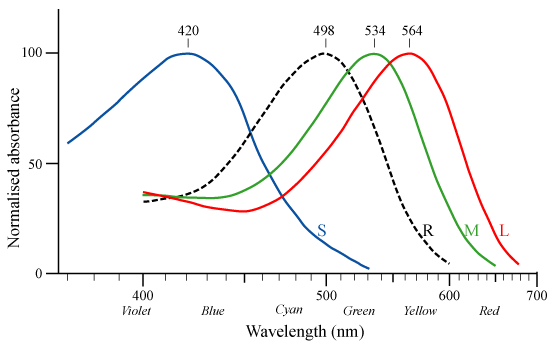
Cohen simplified the concept of 'human color vision is RGB,' and said that there are three types of 'filters' that affect how colors are actually seen. The filters are the stages through which the signals received by the three types of cone cells are processed before being sent to the brain. The first filter sends red as a positive signal and green as a negative signal. Cohen points out that this also explains why there is no such thing as a 'greenish red,' since green and red are considered to be ' opponent colors .' When there are equal amounts of R and G, they do not combine, but rather the positive and negative balance out and the signal becomes 'zero.'
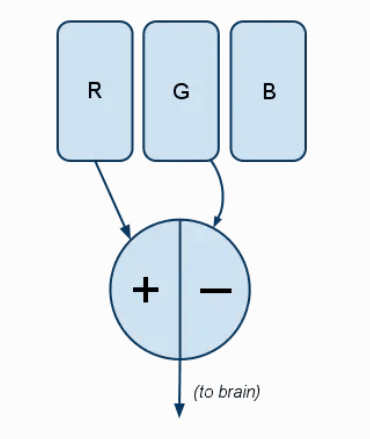
The second filter classifies red and green as positive signals and blue as negative signals.

The third filter measures the amount of light regardless of hue, which is equivalent to 'luminance,' or brightness.
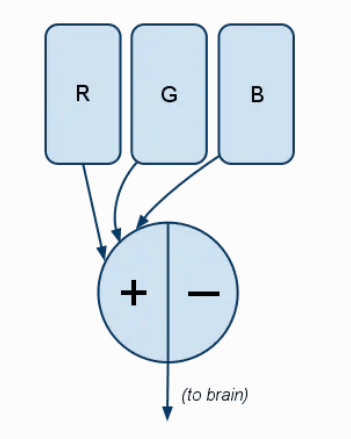
According to Cohen, we perceive color by combining these three filters. If we were to think in accordance with this color vision, we would need to show the opposing colors of red and green, and blue and yellow. Therefore, if we were to show a physiologically correct color wheel, Cohen shows that there would be four primary colors instead of three, and the diagram would look like the one below. The reason it is circular is that in terms of calculating positive and negative signals, it is a natural diagram when you map the numbers 'from positive through zero and then negative.'
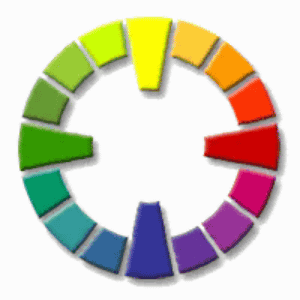
Cohen's article was written in 2011, but it was picked up by the social news site Hacker News around July 2024 and became a hot topic. There, it was pointed out that although the question 'Why circular (wheel)?' is interesting and the conclusion is reasonable, 'the author has not been able to support the idea that the color wheel is wrong.' Cohen explains that 'the opposite color of red is green' and 'the opposite color of blue is yellow,' but the opposite color of red in RGB is cyan, and the opposite color of red is yellow in RYB. However, the opposite color of blue in RYB is orange, so the standard is not consistent. There are also opinions that the color wheel with four primary colors that Cohen showed at the end is missing some important color combinations.
Also, according to one user , it is a common misconception that 'color is determined by the frequency of light.' It is not a single frequency of light that determines color, but the 'entire distribution' of the visible light spectrum, which is why mixing a red laser with a green laser results in a yellowish color. On Hacker News, there are discussions about Cohen's theory, the concept of color and the color wheel, and what colors a rainbow appears in. 'The subject of color forces us to question whether all understanding is purely psychological,' one user said.
Related Posts:
in Design, Posted by log1e_dh
